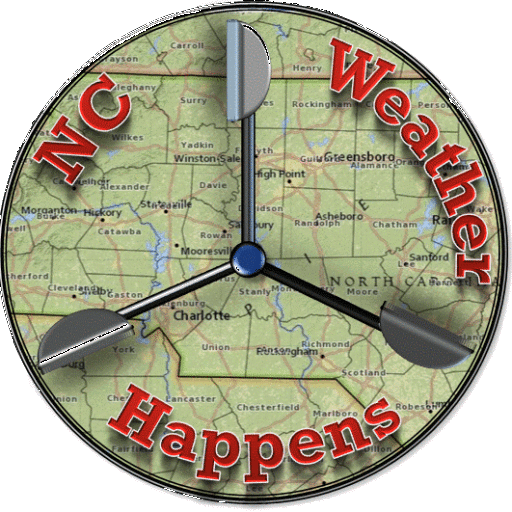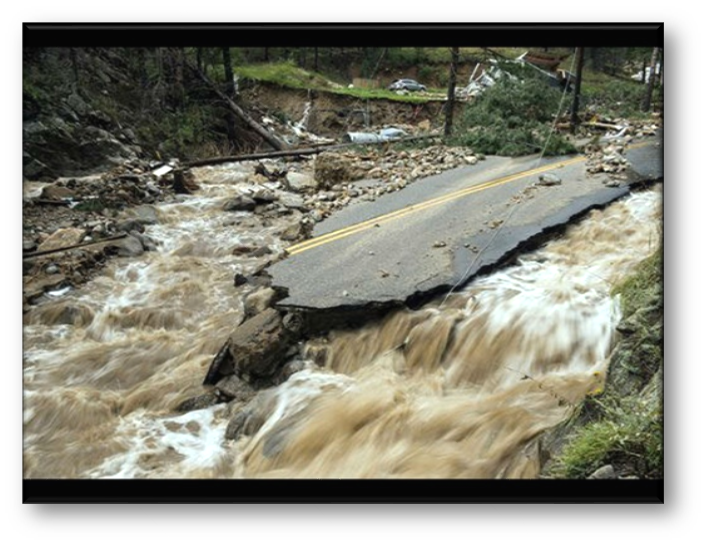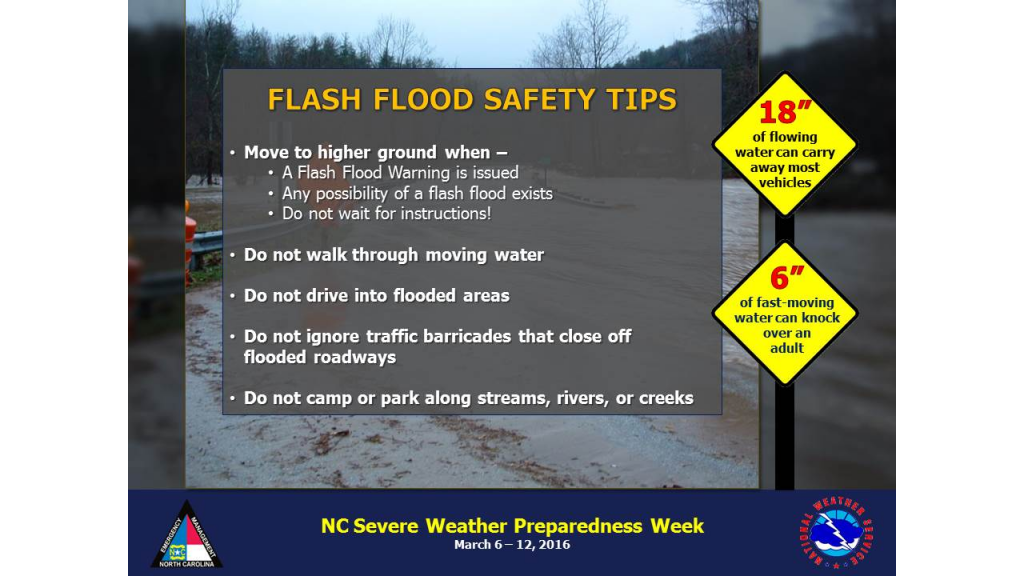Severe Weather Preparedness Week in North Carolina is March 5-11, 2016 Today’s Topic:
Flash Flood Safety
Flash flooding in North Carolina usually occurs when a large amount of rain falls in an area over a short period of time. The ground can only soak up so much water in a given time, and when the rain rate exceeds what can infiltrate into the ground or run off into drainage systems or streams, flooding is likely to occur. Hurricanes, tropical storms, and ordinary thunderstorms can produce flash flooding.
More people die from floods each year than from tornadoes, lightning, or hurricanes. Forecasters can usually predict where flooding will occur when a hurricane or tropical storm affects an area. However, when dealing with thunderstorms, predicting flash floods can be nearly impossible due to their isolated nature. Flash floods usually occur in low-lying areas where water can collect or in cities where water runoff from impermeable surfaces can fill roads or storm drains quickly.
In the past 10 years, flash flooding has occurred in North Carolina over 1000 times, amounting to damages on the order of hundreds of millions of dollars, and resulting in numerous fatalities. Being prepared and knowing how to stay safe will help you and your loved ones survive a flood.
Prepare:
Knowing your flood risk is the best way to prepare for flooding. Determine if you live in or near locations that are prone to flooding. You can find out if you live in a flood plain by visiting our partners at FEMA at https://msc.fema.gov.
Be aware:
Find the latest forecasts and hazardous weather conditions at http://weather.gov and http://water.weather.gov. Forecasters in NWS offices work around the clock to ensure watches, warnings, and advisories are issued to alert the public to hazardous conditions. The same information is available on your mobile device at http://mobile.weather.gov. Most cell phones are able to receive flash flood warnings via the Wireless Emergency Alerts system. Visit http://www.nws.noaa.gov/com/weatherreadynation/wea.html for more information.
Another tool to alert you to hazardous conditions is NOAA all hazards radio. This nationwide network of radio stations broadcasts continuous weather, river and other emergency information direct from NWS offices and emergency officials. For more information, visit http://www.nws.noaa.gov/nwr.
Be safe:
Flooding is one of the leading causes of weather related fatalities in the US. On average, flooding claims the lives of 89 people in the US each year. Most of these deaths occur in motor vehicles when people attempt to drive through flooded roadways. Many other lives are lost when people walk into flood waters. This happens because people underestimate the force and power of water, especially when it is moving. The good news is most flooding deaths are preventable with the right knowledge.
Just six inches of fast-moving water can knock over an adult. Only eighteen inches of flowing water can carry away most vehicles, including large SUVs. It is impossible to tell the exact depth of water covering a roadway or the condition of the road below the water. This is especially true at night when your vision is more limited. It is never safe to drive or walk through flood waters. Any time you come to a flooded road, walkway, or path, follow this simple rule: turn around, don’t drown.
Remember these flash flood safety tips:
- If a flash flood warning is issued for your area, or if there is any possibility of a flash flood, move immediately to higher ground. Do not wait for instructions to move.
- Do not walk through moving water. Six inches of moving water can make you fall.
- Do not drive into flooded areas. If floodwaters rise around your car, abandon the car and move to higher ground, when water is not moving or not more than a few inches deep. You and the vehicle can be swept away quickly. If your vehicle is trapped in rapidly moving water, stay in the vehicle. If the water is rising inside the vehicle, seek refuge on the roof.
- Do not disregard or drive around traffic barricades that close off flooded roadways.
- Do not camp or park your vehicle along streams, rivers or creeks, particularly during threatening conditions.
Understanding the different flood hazards and knowing the actions to take before, during, and afterwards can help you protect your life, the lives of your loved ones, and your property. Prepare now by visiting http://www.floodsafety.noaa.gov.
Tomorrow’s Topic: Making an Plan and Encouraging Others To Do The same
NC Weather Happens. Enjoy it!
Be sure to get articles like this in your email by subscribing at ncwxhappens.com…its Free, No ads, and No spam but more importantly, No delay! We are also on Twitter @ncwxhappens.
Advertise your business on this high volume webpage. Send us a note and we’ll send you some information.



